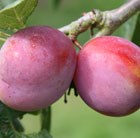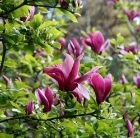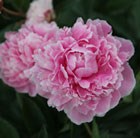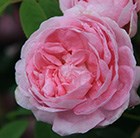New products at Crocus
by Sarah - September 9th, 2009.Filed under: Crocus, New Products.
New lines today at Crocus

plum £32.99
Position: full sunSoil: will tolerate most soils, except very chalky or badly drainedRate of growth: slow growingUltimate size on St Julian rootstock: 4 x 4m (13x13ft)Ultimate size on Pixy rootstock: 3 x 3m (10x10ft)Flowering period: April to MayFlower colour: whiteOther features: top quality culinary or dessert plum (late September)Hardiness: fully hardyA reliable, self-fertile plum which produces a heavy crop of large, pale red fruit with golden-yellow flesh, which can be used for cooking, canning, bottling or just eating fresh. The single, white flowers are produced in spring and fruiting picking can start in late August. It is one of the most popular plum trees available but does need the fruit to be thinned to avoid biennial fruiting.Garden care: When planting incorporate lots of well-rotted garden compost in the planting hole and stake firmly. Prune in summer to reduce the risk of silver leaf and bacterial canker.

leaf-skeleton-lights £21.99
These lovely indoor lights are made from preserved rubber tree leaves. The leaves are handmade into flowers and attached to a static light set 4 metres long. Each set has 35 light bulbs. The leaf lengths are around 8cm. These lights are made from natural materials and should not be left on unattended.

leaf-skeleton-lights £21.99
These lovely indoor lights are made from preserved rubber tree leaves. The leaves are handmade into flowers and attached to a static light set 4 metres long. Each set has 35 light bulbs. The leaf lengths are around 8cm. These lights are made from natural materials and should not be left on unattended.

magnolia £14.99
Position: full sun or partial shadeSoil: moist, well-drained, slightly acidic soilRate of growth: slow-growingFlowering period: June to SeptemberFlower colour: dark purple-redOther features: slightly fragrant flowersHardiness: fully hardyA stunning, deciduous magnolia with a compact habit and dark purple-red flowers which appear from an earlier age than most magnolias. The goblet-shaped blooms are produced from early summer, and then intermittently into autumn. A lovely shrub for a sunny or partially shaded spot out of strong winds.Garden care: Requires minimal pruning. Remove any broken, diseased or crossing branches after flowering. The best time to plant is in April, adding plenty of peat to the planting hole, in a sheltered spot. Mulch in spring with manure and leafmould, especially on dry soils

New Zealand flax (Phormium Rainbow Queen) £14.99
Position: full sun/partial shadeSoil: fertile, moist, well-drained soilRate of growth: averageFlowering period: JulyHardiness: frost hardy (may need winter protection)With their arching, strappy, sword-shaped leaves, Phormiums make a dramatic statement in the garden. Originating from New Zealand, where their fibre has traditionally been used in the same way as hemp or sisal, they are versatile evergreen plants that tolerate a range of conditions and look at home in a variety of different planting schemes. They have become increasingly popular in recent years, with more and more colourful varieties being introduced. This one has broad, bronze-green leaves with rose-red margins, and a sliver of cream at the edge. This dramatic, evergreen, architectural plant adds a touch of exotica to a sunny, sheltered spot in the garden. In hot summers, a spike of tubular, red flowers will shoot up from the centre, followed by sturdy seed-heads. Garden care: In late spring remove any dead or damaged leaves and apply a mulch of well-rotted organic matter to stimulate vigorous, new growth.

paeony / peony £6.99
Position: full sun or partial shadeSoil: fertile, moisture-retentive yet well-drainedRate of growth: averageFlowering period: June to JulyFlower colour: pinkOther features: ideal as cut flowersHardiness: fully hardyEnormous, rose pink, fragrant, double summer flowers and mid green leaves. This magnificent, late-flowering, pale pink peony has been popular since the Edwardian era. To support the large flowers stake in spring using bamboo canes or metal link stakes. An excellent specimen plant for a partially sunny border. Garden care: Deadhead after flowering. In early spring apply a balanced slow-release fertiliser around the base of the plant and mulch with well-rotted compost or manure. Fungal diseases may occur in cool, wet springs so prune out any affected parts and spray the remaining sections with fungicide.

paeony / peony £6.99
Position: full sun or partial shadeSoil: fertile, moisture-retentive yet well-drainedRate of growth: averageFlowering period: June to JulyHardiness: fully hardyPrized for their blowsy, glamorous blooms and glossy, deeply cut foliage, peonies are held in deep affection by many gardeners, despite their shortish flowering season and vulnerability to peony wilt in damp weather. It's easy to see why. From the promise of early spring, when their red, mottled shoots push through bare earth and the handsome foliage unfurls from spherical red buds, to early summer, when the huge flowers burst open, peonies exert a fascination that few can resist. 'Shirley Temple' is later flowering than many peonies with large, pale pink,double flowers, gently fading to buff-white, and mid green leaves. The centre of each beautiful, scented flower is full of small, loosely arranged ruffled petals. It will thrive in full sun or partial shade. Fill the bare ground around the peony before the leaves appear with spring bulbs to prolong the season of interest. Garden care: Deadhead after flowering. In early spring apply a top dressing of a balanced, slow release fertiliser around the base of the plant and mulch with well-rotted compost or manure. If the plant shows signs of collapse or the leaves become spotty, this may be a symptom of peony botrytis. Remove affected leaves immediately. In the autumn, cut off all the foliage and dispose of it to prevent reinfection the following spring.

rose Queen of Denmark (shrub) £6.49
Position: full sun or partial shadeSoil: fertile, humus-rich, moist, well-drained soilRate of growth: fast-growingFlowering period: JulyFlower colour: glowing pinkOther features: excellent cut-flowersHardiness: fully hardyClusters of huge, fully double, very fragrant, deep to light pink blooms in midsummer which stand out against the grey-green foliage. Perhaps one of the finest old-fashioned roses, this shrub rose is ideal for an open, sunny site. Though a vigorous grower it is also disease resistant.Please note : All our roses have had a summer prune to tidy them up so they will not be in flower when you receive them.Garden care: Before planting shorten thick roots to 25cm (10in) and reduce top-growth to an outward-facing bud 8-15cm (3-6in) above ground-level. Plant during a frost-free spell, incorporating well-rotted organic matter and a balanced fertiliser into the planting hole. Ensure that the 'bud union' (the bulge at the base of the shoots) is 2.5cm (1in) below the soil.All our roses are field grown. In October/November they are dug up and potted. However, they will not produce any new roots until spring, so don't be surprised if the compost falls away from the roots when winter planting. Some suppliers send out 'bare root' plants unpotted, but we don't as it is easier to manage them on the nursery in pots.

alpine strawberry – woodland £5.99
Position: full sun or partial shadeSoil: any soilRate of growth: fast-growingFlowering period: MayFlower colour: whiteOther features: makes a useful groundcoverHardiness: fully hardyA great little plant, which will produce edible strawberries in summer provided they have a sunny spot. Unfortunately though the small fruits are not as sweet and full of flavour as their closely relatated, cultivated varieties. Nevertheless, this is a wonderful groundcovering plant with bright green, 3-palmate leaves that remain on the plant throughout the year, except in very harsh winters. A lovely addition to the edge of a cottage garden bed, or for lining an open, woodland walkway.Garden care:Cut off runners from the parent plant and transplant the new plantlets to increase stock.
knapweed £5.99
greater quaking grass £3.99






